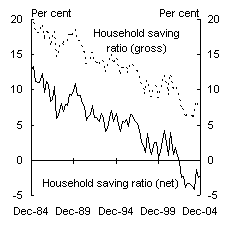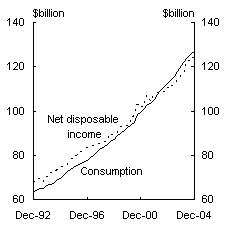Treasury submission to Senate Economics References Committee public inquiry
12 March 2005
Overview
Australia has run a current account deficit for all but two of the past 50years. Since the early 1980s it has generally fluctuated between 3 and 6percent of GDP, in line with the business cycle and swings in world commodity prices.
The current account balance reflects the saving/investment balance within the Australian economy. In contrast to previous decades, the government sector is close to balance. The corporate sector is also close to balance, with investment being funded from strong profits. The current account deficit therefore reflects the excess of households’ investment over their saving. This is being indirectly financed from overseas, through the banking system.
Households have spent in excess of income, in part because increased house prices have led to increased household wealth. The rise in house prices reflects an adjustment to sustained low inflation and interest rates, among other factors. However, activity in the housing market can not be sustained at the pace seen in recent years. As the housing market cools, growth in consumer spending should ease and household saving rise, resulting in a tendency for the current account deficit to fall, everything else equal.
The increase in household debt also partly reflects the deregulation of the financial system over the past two decades. This has shifted the regulatory focus in the financial sector from a model based on restricting market forces to one based on minimum prudential standards, increasing disclosure and improving market conduct.
Deregulation has been an important driving force in providing a competitive stimulus to the financial sector, improving its efficiency and performance. Consumers have also benefited from improved product choice and reductions in borrowing costs.
The current account
Introduction
The current account of the balance of payments comprises the ‘trade balance’ or ‘balance on goods and services’ (exports less imports) and the ‘net income balance’ (interest, dividends and transfers received by Australians less interest, dividends and transfers paid to foreigners).
Australia has experienced a deficit on the current account for nine years in every ten since European settlement, and for all but two of the last 50years. By definition, it has also run a surplus on the capital account in all these years, attracting net capital inflow which indicates investment opportunities in Australia continue to be attractive to overseas investors.
Over the past twenty years, the current account deficit (CAD) has fluctuated between, broadly, 3 and 6percent of GDP (Chart1). Most of the fluctuation has been a reflection of changes in the trade balance, since the net income deficit has been relatively stable, or slowly declining, since its sharp run up in the mid-1980s.
Chart 1: Current account balance as a per cent of GDP
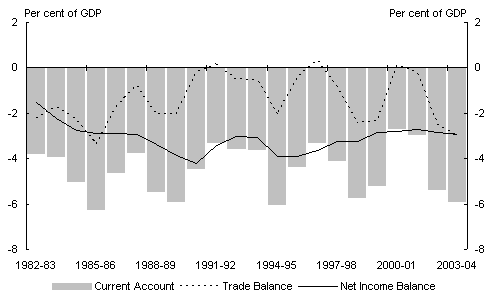
Source: Australian Bureau of Statistics cat. no. 5302.0 and 5206.0.
The trade balance tends to move with the economic cycle. When domestic demand grows faster in Australia than in the rest of the world, import volumes tend to rise more than export volumes and so the trade deficit becomes larger (as has happened recently). During the recession of the early 1990s (and the slowdown around 2000), import volumes were more subdued and the trade deficit was correspondingly smaller. Fluctuations in the CAD are not a bad thing. They are a means by which Australia smoothes consumption in the face of income shocks, such as the Asian crisis. That is, the CAD, like the exchange rate, acts as a buffer or shock absorber between domestic demand and global developments.
Imports consist of consumption goods for households; intermediate and capital goods that Australian firms use to produce goods for domestic sale and export; and services (a large component of which is spending by Australian tourists abroad). Import volumes have grown strongly recently. Growth in export volumes has been weak, despite a strong world economy.
The other major influence on the trade deficit is the ‘terms of trade’, that is the ratio of export prices to import prices. As Australia is a net exporter of commodities and a net importer of manufactures, the terms of trade tend to rise when commodity prices rise, which is generally when the world economy is buoyant. The floating exchange rate buffers the effects of swings in the terms of trade on the economy to some extent, as it tends to appreciate when commodity prices are rising and depreciate when commodity prices fall.
The deficit on the net income balance largely reflects past current account deficits. These have been funded by borrowing from the rest of the world, or by selling assets. As a result, the rest of the world’s holdings of Australian assets exceed foreign assets held by Australians. The interest and dividend flows on these net foreign liabilities generally lead to an income deficit.
About half of Australia’s foreign liabilities are initially issued in currencies other than the Australian dollar (particularly the US dollar and euro). Firms and banks which issue these liabilities in foreign currencies typically ‘hedge’ their currency exposure by using the Australian dollar swap market to convert their liabilities into Australian dollars. Accordingly, the bulk of Australia’s foreign liabilities are effectively in Australian dollars. Firms with foreign liabilities that do not use currency hedges will typically hedge their currency exposure in indirect ways, like matching the currency denomination of particular assets and liabilities. Therefore, depreciation of the Australian dollar has minimal direct impact on the liabilities of Australian firms and financial institutions. The story about assets is different. Because most of Australia’s foreign assets are denominated in foreign currencies, depreciation of the Australian dollar will increase the value of these assets in Australian dollar terms.
The current situation
Chart1 shows that the current account deficit is at the high end of the historical range. This reflects some offsetting factors. There is currently very strong demand for our resource exports. This is reflected in high prices for these exports, but so far there has been little rise in export volumes. This is partly due to firms underestimating the strength of global demand and the lags associated with expanding capacity. Furthermore, the diversity of ownership of the various linkages between mines and ships has made coordination of improvements to transport and port facilities difficult. Nevertheless, there is a substantial amount of investment currently under way, which should allow significant expansion in these exports in coming years. The volume of manufactures exports has been weak for some time. This reflects maturing of the sector, the appreciation of the Australian dollar, growing sophistication of Asian competitors and perhaps some diversion of production as a result of high domestic demand.
Strong domestic demand means that spending on both domestically produced goods and imports is high.1 Domestic demand is being supported by strong growth in incomes and wealth. While real GDP expanded by 1percent through 2004, the rise in the terms of trade meant that real national income grew by almost 3percent (Chart2). Increases in household wealth, and a greater willingness and ability for households to take on debt, have allowed spending to outpace incomes in recent years. In addition to domestic demand, the appreciation of the exchange rate during 2003, the ongoing price falls for comp
uters and other electronic goods and the impact of Asian producers on manufactures prices have all acted to lower the price of imports, making them more attractive to domestic buyers.
Chart 2: Real production and income
(percentage change through the year)
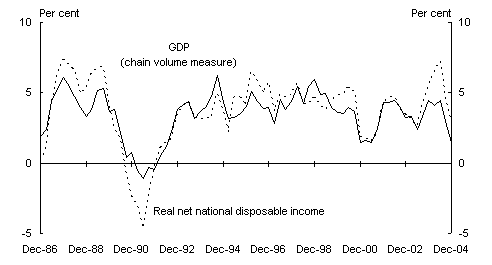
Source: Australian Bureau of Statistics cat. no.. 5206.0.
The current account from a saving/investment perspective
While the CAD is most commonly discussed from a trade perspective, it is best understood within a saving/investment framework. The first three panels of Chart3 show ‘net lending’ (when saving exceeds investment) or ‘net borrowing’ (when saving falls short of investment) by government, corporations and households in Australia. The final panel is the current account balance (which can be thought of as ‘net borrowing’ by Australia from the rest of the world). As they are based on national accounting identities, the numbers in first three panels must always sum to the current account balance.
Chart 3: Net lending
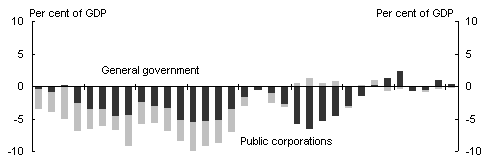
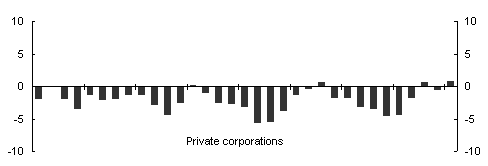
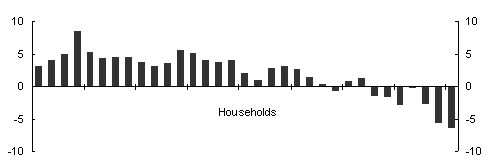
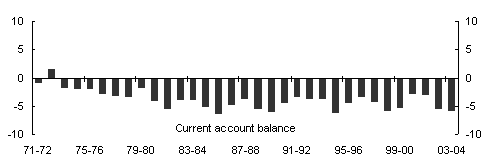
Source: Australian Bureau of Statistics cat. no. 5204.0, 5302.0 and Treasury (original data).
At present, corporations are small net lenders. While business investment is solid, high corporate profits mean that corporate saving is also high.2 In the 1970s and early 1980s the public (government and public corporations) sector was consistently a large net borrower. But in recent years, the federal budget has been in surplus, consistent with the medium-term fiscal strategy. Combined with aggregate budget outcomes close to balance in the state and local government sector, this means the general government sector as a whole is a small net lender. Furthermore, after the series of privatisations that occurred over the 1980s and 1990s, public corporations now play only a small role in the economy. The government sector is therefore not a contributor to the current account deficit.
The counterpart to the current account deficit in recent years is the net borrowing by households. The household sector has been borrowing (indirectly, via the banking system) from the rest of the world to fund spending in excess of income.
The household sector
Household investment and saving
Over the past 15 years the household sector has changed progressively from being a net lender to the rest of the economy to being a net borrower. This reflects both an increase in household investment and a large trend fall in household saving.
Household investment has been very strong over recent years.3 Strong population growth and household formation have provided solid underpinnings for the housing market.4 Interest rates have been low and stable. Over a third of the demand for housing finance over recent years has come from investors, mostly individuals, attracted in large part by the strong gains in house prices observed until recently. However, forward indicators of dwelling activity are consistent with anecdotal evidence of an easing in the housing market.
Household saving is most commonly presented relative to household net disposable income, as the ‘household saving ratio’ (the lower, solid line in panel (a) of Chart 4). This ratio has been declining since the late 1970s. Since mid-2002, the household saving ratio has been negative — on this measure, households have been spending more than their income (panel (b)).
It is important to understand the limitations of the household saving ratio as a measure of household saving. First, the household saving ratio is prone to revision, as it is calculated as a residual item between household income and consumption, and hence is subject to revisions to either of these aggregates. In one extreme case, the March quarter 1996 National Accounts reported a household saving ratio of 0.1percent, which has subsequently been revised up to 5.8percent. Second, capital gains are not included as income (but payments of capital gains tax detract from income) and households almost certainly regard unrealised capital gains as a form of saving.5 Third, an estimate of depreciation on dwellings is subtracted from national accounts measures of household incomes, although this is not a cash outlay for households in reality.6 As depreciation is mechanically assumed to rise with the cost of building houses, this imputed subtraction has been growing. Fourth, the definition of ‘households’ includes unincorporated enterprises. Some of these are family farms, whose income varies with seasonal conditions, making the saving ratio more volatile. There has also been a trend towards small businesses incorporating, and so leaving the ‘household sector’. If they had been net savers, this would be pulling down the household saving ratio. Despite these problems, the broad conclusion that households are saving proportionately less of income now than in the past is likely to be correct but should not be regarded as surprising.
A rise in household debt represents a rational response to the deregulation of the financial system, which allows consumers to smooth their consumption more efficiently over their life cycle. Lower inflation, leading to lower nominal interest rates, has also made it easier for households to borrow more.7 This effect has been amplified by greater competition in the home lending market, which drove down mortgage interest rates further.8 The increased ability of households to borrow probably helped to drive up house prices, thereby increasing the amount households needed to borrow.
|
Chart 4: Households |
|
|
(a) Saving ratio |
(b) Consumption and income |
|
|
|
|
Source: Australian Bureau of Statistics cat. no.5206.0. |
Source: Australian Bureau of Statistics cat. no.5206.0. |
|
(c) Debt-to-income |
(d) Interest payments-to-income |
|
|
|
|
^ Includes unincorporated enterprises +Income is after tax and after the deduction of interest payments Source: RBA. |
Source: Australian Bureau of Statistics cat. no.5206.0. |
Household balance sheets
Household debt has increased substantially relative to income in Australia, as it has in many other countries whose financial systems were deregulated and where (real and nominal) interest rates have fallen (Chart 4, panel (c)).9 Whereas in the 1980s Australian households had low debt relative to income by international standards, they are now similarly indebted, with an average debt of around 150percent of annual income. The increase in debt means that, despite lower interest rates, interest payments now take up a higher proportion of income compared with the past decade (Chart4, panel(d)).
It is important to appreciate that these are average figures across all households. For example, only a third of households have a mortgage, and the average debt-to-income ratio for these households will be higher. Treasury analysis suggests that older households have accounted for an increasing proportion of dwelling purchases. These households are likely to be better placed to meet loan repayments.10 Furthermore, other studies suggest household debt is mostly being borrowed by households with higher incomes who are better placed to bear it (Chart 5).11
Chart 5: Household gearing (ratio of debt-to-assets) by income
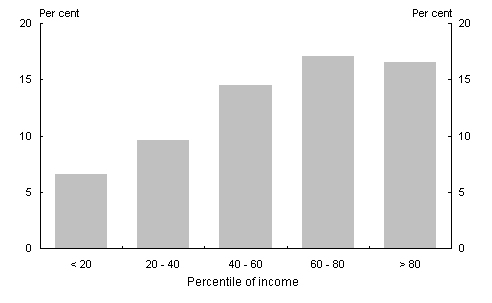
Source: Household Income and Labour Dynamics in Australia survey.
Assessing whether lower household saving and increased borrowing should raise concerns requires placing the debt in the context of household balance sheets. Household gearing (debt/assets) has been steady in recent years. For every dollar of debt, households have around $2 in financial assets and more than $6 in total assets.
There is so far little evidence that households as a whole have become overextended in terms of debt. As the Reserve Bank of Australia notes in its February2005 statement on monetary policy, ‘at this stage the servicing burden does not appear to be constraining households, with indicators of financial stress—such as loan arrears—remaining low.’ However, the household sector is now more sensitive to shocks such as higher interest rates or lower income.12
The economic outlook and implications
The increased debt of the household sector is likely to make their consumption more sensitive to changes in (actual and expected) interest rates. The extent of the increase in sensitivity will depend on the distribution of the debt. For example, investors, some of whom are more highly geared, account for an increasing proportion of the housing market, and may react differently to owner-occupiers.
Interest rates have become less volatile than in the past as a result of the economy becoming more stable. Furthermore, as the Reserve Bank is aware that households now have more debt, it recognises that it needs smaller changes in interest rates to achieve a given effect on household spending.
Treasury is forecasting both unemployment and inflation to stay at low rates. If house prices were to fall more sharply than expected this could have implications for economic activity. Current information indicates, however, that the housing cycle is unwinding and, provided this continues in a measured way, this cycle will be muted compared with previous cycles. In part, this reflects the household sector continuing to be supported by favourable economic conditions with strong employment growth and high levels of consumer confidence.
As the housing market cools, growth in dwelling investment and consumer spending should ease and household saving rise, reducing the size of the current account deficit.
The changing role of regulation
Up until the 1980s, the Australian financial system was heavily regulated and restrictive. Interest rate controls were in place and loans were rationed and only available to the most credit worthy borrowers. Competition from foreign banks was restricted and the banking system was effectively closed to offshore transactions.
In 1979, the Government established the Campbell Committee to recommend changes to the regulatory structure of the financial system to promote efficiency and stability. These changes were the Government’s first formal attempt at financial system reform and were followed by another formal reform programme in 1996 with the Financial System Inquiry (the ‘Wallis Inquiry’).
Through successive reforms over the 1980s and 1990s, the Government has shifted the focus of regulation from restricting market forces to a model based on minimum prudential standards, increasing disclosure and improving market conduct. In particular, regulations that undermined efficiency, such as interest rate controls and lending restrictions, have been removed. At the same time, prudential supervision has been strengthened to promote sound risk management practices by firms and provide for early detection and resolution of financial difficulties.
Importantly, these reforms do not involve a government guarantee over any part of the financial system. It remains the responsibility of the board and management of financial institutions to ensure that the financial promises made to consumers are kept. The reforms only seek to add an additional layer of protection to guard against market failure.
Benefits of financial sector deregulation
The reforms to financial regulation implemented over the past two decades have promoted competitive pressures across the financial sector. In particular, competition in markets, such as home and personal lending, has been enhanced by a number of changes. These include the entry of foreign banks into the Australian market and the establishment of specialist providers in the home lending market. These changes have lowered borrowing costs and improved access to credit, contributing to an increase in the level of household and business borrowing.
The increased levels of competition have contributed to gradual improvements in the efficiency and performance of the financial system. For instance, in the banking sector, prior to the 1980s, interest rate and maturity controls resulted in a pricing structure under which most retail payments and transaction services were provided free of charge. The costs of these services were offset against higher interest margins — the difference between what banks pay on deposits and other sources of funds and what they earn on loans. As a result of these controls, the banking system practised considerable cross-subsidisation among different products and customer groups, creating distortions in pricing signals.
More recently, the pricing of banking services (both fees and interest rates) has begun to reflect more closely the ‘user pays’ principle, with banks charging fees equivalent to 1percent of their assets since 1997 and interest rate margins reducing (see Chart6). These changes have improved resource allocation as they more closely reflect the underlying cost and risk of providing banking services.
As Chart6 shows, fierce competition across the financial sector has lowered the costs of finance, with bank interest rate margins falling considerably over the past decade. This trend has been m
ost pronounced in the residential mortgage market where margins have fallen from 3.6percent in 1994 to 1.8percent in 2004, saving home buyers thousands of dollars in interest on their mortgages. The savings made by customers from a decline in interest rate margins have more than offset any rise in fees.13
Chart 6: Reduction in interest rate margins

Source: RBA Bulletin Statistics F1, F4; KPMG, Financial Institutions Performance Survey, 1994 to 2004.
Increased competition has also provided institutions with an incentive to reduce their production costs. Operating expenses of the major domestic banks (as a proportion of total assets) have been gradually trending downward from just over 3percent of total assets in 1987 to below 2percent in 2004 (KPMG Financial Institutions Performance Survey 1987 to 2004).
Financial sector deregulation has also opened the way for a wider range of financial institutions to offer greater choice in services and products to customers. For instance, in 1980, deposit-taking institutions were the main source of home finance, offering around 26 types of mortgages. There were strict limits on the size of housing loans and a longstanding relationship with the bank was often a prerequisite for loan approval. Mortgage offset accounts and redraw facilities were not even considered. Today, consumers can choose from around 3,000 differentiated mortgage products offered by a range of suppliers. Delivery platforms have also changed, with electronic access points such as ATMs replacing the traditional branch network (see Table 1).
Table 1: Improvements in product innovation and choice

Source: Australian Bankers’ Association, 2004
Concluding comments on financial deregulation
Deregulation has significantly improved the efficiency and performance of the Australian financial system. Increased pricing efficiency in retail banking, for example, has improved resource allocation, while increased competition has provided institutions with an incentive to reduce their production costs. The outcome has been a reduction in interest rate margins and greater ease of access to credit. This has contributed to an increase in the level of household and business borrowing.
1 An article in the Summer 2004-05 Treasury Economic Roundup describes recent trends in imports in more detail.
2 Some commentators have attributed the rising current account deficit to a surge in business investment, pointing to real business investment being a high proportion of real GDP. However, as there has been a significant fall in the relative price of investment goods, nominal investment is not that high as a proportion of nominal GDP, and it is nominal investment, that is actual expenditure, that matters for an analysis of the current account.
3 In this context ‘investment’ refers to capital expenditure, such as building a new house or extending an existing home, not purchases of property or financial assets. See ‘Recent developments in the Australian housing market’, Treasury Economic Roundup, Summer 2003-04, for background information.
4 Furthermore, over the past two decades the average floor area of new dwellings has increased by over a third.
5 The ABS have done some work on estimating the size of the capital gains effect on income and saving; see Table 48 of Australian System of National Accounts, (Cat. No.5204.0), November2004.
6 Comparing the two lines in panel (a) of Chart 4 shows that it is only this imputed depreciation that renders the household saving ratio negative.
7 Most home loans in Australia are ‘credit foncier’ loans where most of the initial repayments go on paying interest but towards the end of the loan most is repaying principal. Typically the maximum size of a loan is determined by the resulting repayment-to-income ratio.
8 The Reserve Bank suggests greater competition was responsible for around 2 percentage points of the 8 percentage point reduction in average mortgage interest rates between the second half of the 1980s and the period 1998-2002. (RBA Bulletin, March 2003)
9 For further information, see G. Debelle ‘Macroeconomic implications of rising household debt’, Bank for International Settlements working paper, no 153, June 2004.
10 For further information, see the appendix on ‘Dwelling ownership as part of Australian household portfolios’, in the Autumn 2003 issue of the Treasury Economic Roundup.
11 Information on the distribution of debt is collected in the Household Income and Labour Dynamics in Australia Survey. Some results from the survey are summarised in M. Kohler, E. Connelly & K. Smith, ‘The composition and distribution of household assets and liabilities: evidence from the 2002 HILDA survey’, Reserve Bank of Australia Bulletin, April 2004.
12 See the discussion of risks in Statement 3 of Budget paper 1, Budget Strategy and Outlook 2004-05.
13 Bank fees are discussed in ‘Banking fees in Australia’, Reserve Bank Bulletin, May 2004.
